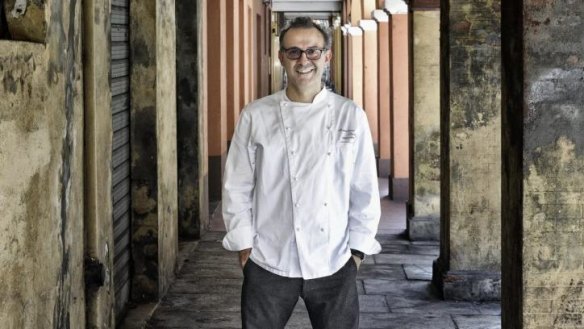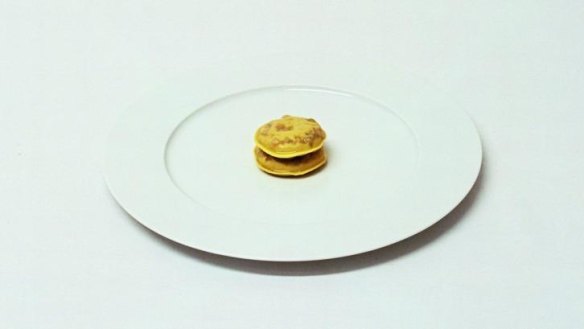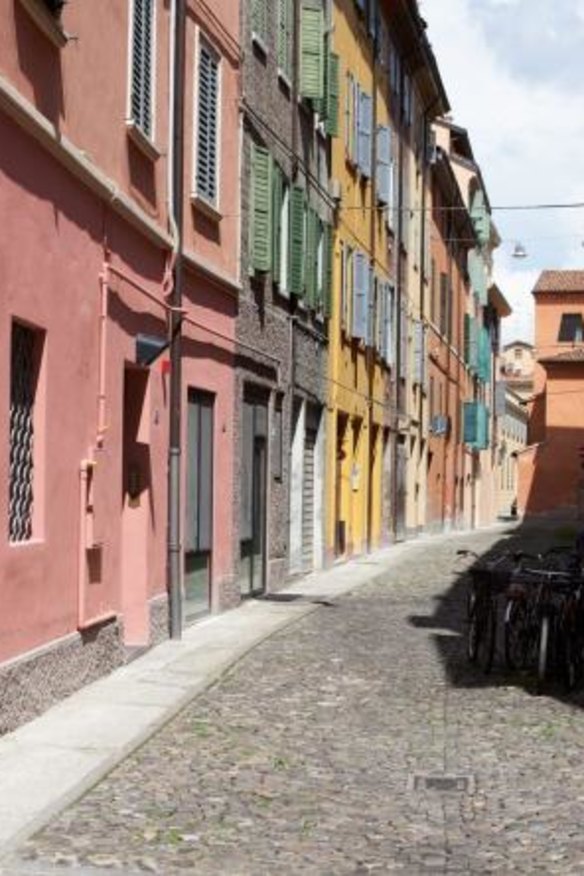Chef Massimo Bottura shares the secrets of Italian cooking

"For me, inspiration comes from many things," Massimo Bottura says. "Thinking about the life of snails under the snow, or listening to a piece of music by Bob Dylan or Thelonious Monk."
Bottura isn't your average Italian chef. But, then again, with menu items named "Chicken, chicken, chicken, where are you?" and "An eel swimming up the Po River," his restaurant Osteria Francescana is not your average red-sauce, checked-tablecloth trattoria either.
Osteria Francescana, is in the Italian town of Modena. It holds three Michelin stars and was ranked third in the 2014 World's 50 Best Restaurants list (the highest position of any restaurant in Italy). Bottura's food is a symphony of finelytuned technique, memory, tradition, regionality, and a love for music and contemporary art.
He is, without question, the greatest Italian chef alive.
"I eat at Osteria Francescana every time I visit Italy," says Alessandro Pavoni, exectuive chef and owner of Sydney's Ormeggio at the Spit.

Although the dishes are plated like avant garde artwork and sound like B-sides from an ambient-rock band (see also: "A potato waiting to become a truffle" and "How to burn a sardine"), Pavoni says Bottura's food is not pretentious.
"If you close your eyes when you eat his food, you don't taste a fancy dish," he says. "You just taste the best regional produce."
Bottura is visiting Australia for Good Food Month and to present his new book Never Trust a Skinny Italian Chef. He will host dinners in Sydney and Melbourne with some of Australia's best chefs including Mark Best (Marque, Pei Modern), Dan Hunter (Brae), Ben Greeno (Momofuku), and Steve Manfredi (Balla). He will also present talks on food, art, and life at galleries in both cities; Bottura is a serious collector of contemporary art.

"He has a vast knowledge of Italian cuisine, especially from his own region of Emilia Romagna," says Best who has previously collaborated with him on a dinner. "He brings his wit, intelligence, and I guess poetry to his food. Everything has a beautiful story and it's not just marketing spin."
Good Food spent time with Bottura ahead of his visit to ask questions about regionality, ragu, and risotto's independence.
What is your cooking philosophy at Osteria Francescana?

I revisit traditional recipes and ideas from the Italian kitchen and make them contemporary. This is my specialty. I try very hard to respect tradition but also respect ingredients, heroic farmers, butchers and fishermen. Sometimes I have to ask if our traditions respect the ingredients and if they don't, then it is time to rework them. I call this Tradition in Evolution.
As for my cooking style, it is clean, minimalist and most of all conceptual. Every plate on our menu begins with an idea or a colour, a piece of music, a landscape, or a memory. From there we elaborate, add and subtract, and reduce ingredients to their essence.
Five Temperatures and Textures of Parmigiano Reggiano is a perfect example of my cuisine. It is a monochrome in shades of white. It is specifically about one ingredient and one idea explored in depth with different techniques. This dish is grounded in terroir and yet projecting into the future. At the end of the day, the evolution of ideas is what counts for me. Only then do I feel that I am contributing to the rich culinary traditions I come from.
What do you see as the future of Italian food?
Italy's greatest resource is its artisans. We must support them and reflect light on them in order to guarantee that the next generation of artisans will be there for our children and grandchildren. It is very important that young chefs do not lose themselves in their own dreams of grandeur but keep building for the future of Italy.
Think about the power of Slow Food and how it has changed a generation of chefs. This is the trend for the next decade, and maybe forever. Some day instead of chef superstars there will be farmer superstars. That will be a great day indeed.
What advice you would give someone who wants to become a better Italian home cook?
Buy the freshest, best ingredients you can. Know your farmer, your butcher, your cheesemaker, and your fishmonger. When you have a relationship with the people who produce your food, it will always be better quality.
Try to respect the ingredients on the table. Keep recipes simple, with distinct flavours that do not cover one another. What is better than tasting the real flavour of something, even as simple as a potato?
In Never Trust A Skinny Italian Chef your recipe for ragu uses sous-vide with each meat cooked separately and mixed together at the very end. How would you make the perfect ragu if you didn't have access to a sous-vide bath?
Out of the tradition of never throwing anything away, meat ragus were made with leftover cuts of pork, beef, chicken and duck. The recipe for ragu in my book calls for the meat and soffritto to be cooked for 24 hours sous-vide but here is my basic ragu recipe for home cooks, which can be adapted to various palates. It calls for various cuts of veal and beef; however, the ragu can also be made with white meats, such as chicken or rabbit and duck. I usually do not add sausage but some people do.
The most important rule of any ragu is not to grind the meat. Keep it in chunks and cut into bits only when it is fully cooked. Not only does this change the consistency of the ragu but it deepens the flavour. I tend to keep the ragu focused on the flavour of the meat by not adding extras like garlic or aromatic herbs.
Begin with a soffritto - a finely diced preparation of carrot, onion, celery. Lightly saute in olive oil until cooked properly. Then add the meat. Brown evenly. Add a touch of white wine to add flavour. The meat should begin to simmer and create a nice juice of its own. For extra deliciousness, add some bone marrow. Simmer on very low temperature for about three to four hours. Cool and chop the meat by hand.
This recipe calls for no tomatoes. Emilia was not a tomato-producing region of Italy until about 50 years ago. I find it distracting to the mellow flavour of the meat.
Serve with pasta cooked al dente in salted water. Finish the cooking in the ragu sauce over medium heat. Add freshly grated parmigiano reggiano at the very end.
What makes a good lasagne?
My mouth waters just thinking about lasagne.
In Emilia we prepare our lasagne with ragu and besciamella (bechamel sauce) in layers between egg pasta sheets and some grated parmigianoreggiano cheese on top.
Lasagne is one of my favourite dishes in the Italian kitchen. I am not a fan of southern Italian versions with mozzarella or tomato because at heart, I am a traditionalist.
What are the best type of canned tomatoes to use?
I always prefer small tomatoes like the Piennolo variety canned whole or the pulp of San Marzano tomatoes. I never buy diced tomato nor thick tomato conserve in which the tomatoes have already been cooked down and reduced.
Canned tomatoes are a great resource and there are some excellent producers out there from Italy as well as other countries.
Can risotto ever be left to its own devices or does it require constant attention and stirring?
Risotto can never be left to its own devices.
What is your ultimate antipasti plate?
A freshly made mozzarella, some green olives from southern Italy, a few slices of culatello (cured ham more prized than prosciutto) with a spicy apple mostarda (candied fruit and mustard syrup), toasted semolina bread with olive oil on top, a salad of pickled vegetables, sweet gorgonzola cheese with sour cherry jam, and a couple of slices of artisanal salami. I could eat that everyday!
What are four pantry items essential to cook great Italian food?
reggiano cheese, prosciutto, handmade egg pasta, balsamic vinegar and so on but I think the most important ingredient to use in the kitchen is one's mind. Too often people cook with their hands and not their brains. Actually, you need both.
1. Extra-virgin olive oil. (He loves oil from Tuscany, Lake Garda, Liguria, Umbria, Calabria and Sicil – each has its own personality).
2. Capers. The base of many sauces and the secret ingredient to many recipes. The best for cooking are cured under salt.
4. Citrus fruits. (He loves Soorrento lemons, Sicilian oranges and Calabrian Bergamot lemons.)
5. Italian wine.
Is it ever better to use dry pasta instead of fresh pasta?
Whichever you use, make sure the pasta is good quality. If using dried pasta, choose shells or tubetoni, so your sauce can fill in the empty spaces.
* Visit goodfoodmonth.com for details and tickets to Massimo Bottura's events. Never Trust a Skinny Italian Chef is available now through Phaidon Press for RRP $79.95.
Get to know Massimo
Massimo Bottura was born and raised in Modenain Italy's Emilia Romagna region. "Modena can be defined as the place of slow food and fast cars," Bottura says.
As a child, Bottura could always be found underneath the kitchen table, usually seeking refuge from his three older brothers. Here he would find solace at the feet of his grandmother as she rolled out tortellini for the family meals. "Childhood memories like these are why I became a chef," he says. "I love the kitchen because it can take you across new continents or bring you back to your grandmother's stovetop. Flavours from childhood still haunt me.. It is much more difficult to rethink the classics because you are conditioned by your nostalgic memories, cultural history and your daily experience."
In 1986, at the age of 23, Bottura abandoned a law degree and opened his first trattoria, Trattoria del Campazzo, on the outskirts of Modena. Each day he would wake to "the sounds of tractors, chickens, and Modenese dialect" before peeling potatoes, pushing the dessert cart, and meeting regular diners.
He began building a culinary foundation of regional Italian cooking combined with classical French technique. In 1994 he apprenticed with legendary French chef Alain Ducasse and through contact with Ducasse's producers and chefs learnt the difference between the "fresh, fresher and freshest" of ingredients.
In 1995 Bottura opened Osteria Francescana in central Modena.
"Osteria Francescana is on a little side street in the town," he says. "Every morning people pass by to say hello, from the mayor to the postman. They often find me sweeping the street in front of the restaurant or my wife fixing the flowers because we are the first ones to care about where we live and work."
In the formative years of Osteria Francescana it was difficult just paying the bills, but gradually Bottura earned the trust of the public and critics with his interpretation of traditional Italian cuisine. The process of earning this trust is the motivation behind the title of his book, Never Trust a Skinny Italian Chef. "The title had been with me since I visited friends in LA, in the summer of 2001," Bottura says. "They had been to Osteria Francescana several times. When I entered their kitchen there was a sign: Never Trust a Skinny Italian Chef. I asked myself then and there, "Will I ever be trusted to bring the Italian kitchen into the 21st century?
"I had been at [Ferran Adria's] elBulli in 2000 and my take on the Italian kitchen was radical for the time. I was taking apart everything from zuppa inglese to the Italian classic 'pasta e fagioli' [pasta and bean soup] with a vengeance. At first it was a very difficult process to earn people's trust."
Osteria Francescana was awarded its first Michelin star in 2002, its second four years later and third in 2011. However, Bottura says sharing his town of Modena with international visitors is better than any critical nods.
"At Osteria Francescana we are so lucky that our guests come from halfway around the world to visit us in Modena," he says. "This is the best compliment of all. Better than any stars or rankings."
From our partners
Original URL: https://www.watoday.com.au/goodfood/chef-massimo-bottura-shares-the-secrets-of-italian-cooking-20141016-115nos.html
